Leather has a luxurious, sleek and timeless appeal as well as being robust, durable and long lasting so it’s no wonder we have so many goods made out of leather.
These range from shoes, boots, bags, briefcases, coats, jackets, wallets and even furniture such as sofas, beds and chairs. The list is endless.
However, with many of these items, it is usually only a matter of time before they come into contact with liquid whether it’s from rain, puddles, drink spillages or even snow.
In this guide, we will examine the damage that water can do to leather, learn how to fix it and how to protect your leather from further water damage.
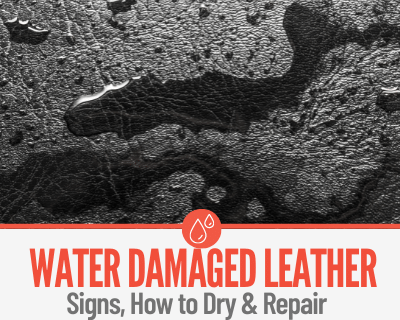
Can Leather Get Wet & Does Water Actually Damage Leather?
Leather can get wet to a certain point for a certain amount of time without suffering any water damage.
This will depend on the type of leather, the source of the moisture/water, how frequently it’s exposed to the moisture & and how the water is removed.
One of the worst-case scenarios is when water is allowed to improperly dry on the leather – as that is when most of the damage occurs.
Other problems usually start due to Long-term exposure to moisture or when mold starts growing on the leather.
Water can absolutely Damage any leather item if care isn’t taken.
If you act quickly and blot up the water the right way after a large spill/submersion, you may not notice any permanent damage.
Here’s What Happens When Leather Gets Wet…
When leather comes into contact with water, the natural oils in the leather bind to the water molecules and as the water evaporates it draws the oils out.
This loss of oil causes the leather to become stiff and brittle.
The moisture can also stain the leather and dyes may move around.
Signs Of Water Damaged Leather
If you are wondering What Does Water Damaged Leather Look Like, there are a few things to look out for.
The level of damage your leather item sustains will depend on the type of leather it is made from, the duration of the contact with liquid and whether it has dried or not.
Unfortunately, prolonged contact with liquid can leave leather looking the worse for wear.
1. Cracked, Hard and Brittle
The loss of natural oils can lead to cracking and a change in texture from soft to brittle.
Replacing these lost oils can help improve the texture and bring back suppleness.
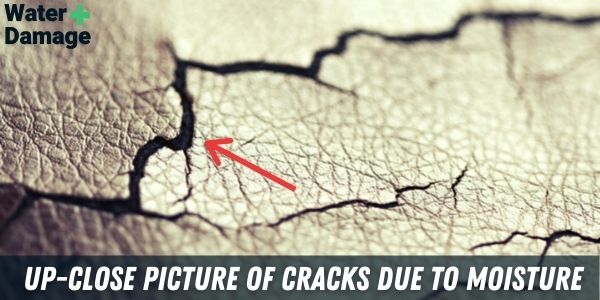
2. Stained and Discoloured with Streaky lines
The dyes can shift around and streaky white lines can appear, particularly in any creases.
It may be possible to fade out these stains and lines and blend them in by cleaning the leather.
3. Dull, Flat and Lack-lustre
The leather can lose its ‘sheen’, looking tired and flat.
Care and maintenance can help the leather keep its’ shine.
4. Signs Of Rot
Severe, Constant Water damage that’s not taken care of can even cause your leather to rot.
By ensuring the leather is fully dry inside and out, you can avoid these problems.
5. Mold Growth
If leather items are exposed to constant excess humidity, mold growth can start to appear on the leather.
This will also cause the leather to start smelling.
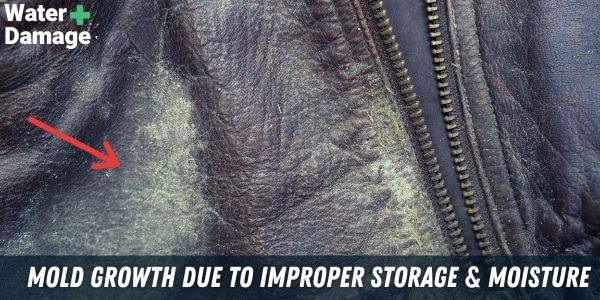
How to Repair Water Damaged Leather
Been caught in the rain? Stepped in a puddle? Or perhaps you split a drink over your leather sofa?
You need to act quickly to minimise the damage.
You can usually repair your water damaged leather items with prompt action, patience and some elbow grease.
What You Will Need
To treat your wet leather, you will need the following items;
- Dry, lint-free cloth, paper towels
- Soft bristle brush or toothbrush
- Good quality leather conditioner
- Newspaper or absorbent paper
- Padded coat hangers (for coats and jackets)
The action you take will depend on the type of leather you have. Here are the main ones and what to do for each.
1. Full Grain Leather
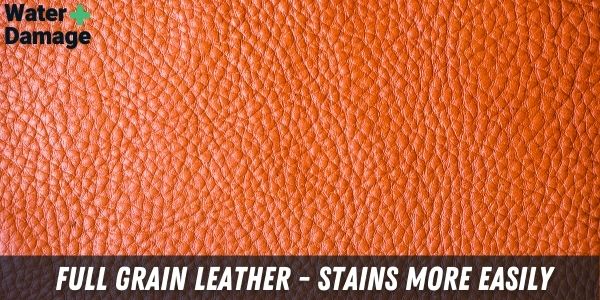
Most Vegetable tanned leather is ‘full grain leather’ which is typically made from the strongest part of the animal hide and thus leaves the skin intact.
This makes it stronger and more durable so it is considered high quality leather.
However, it also means it absorbs water more readily and can stain easily.
If Still Wet
Always wash your hands before treating your leather items.
- Blot excess liquid from the surface of the leather with a soft, dry cloth or paper towels.
- Allow to dry naturally in a well ventilated space.
- Do not use heat or place near heat sources such as heaters.
- Once damp, apply leather conditioner, massage in well and leave overnight to dry out fully.
- In the morning, take a dry cloth and buff the surface of the leather and then apply protector.
If Stains Are Dry
Test a small and hidden area with a high-quality leather cleaner and leave to dry.
Use the product to clean the stained area and clean off any residue.
Allow to dry away from heat and sunlight. Condition as above and protect.
2. Top Grain or Patterned Leather
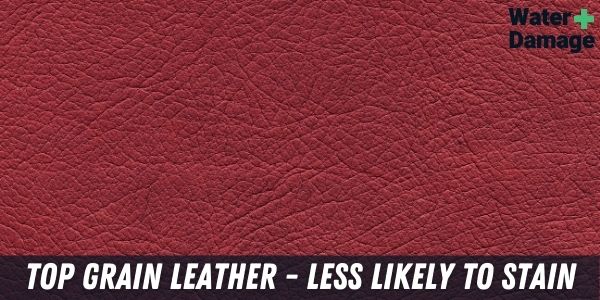
Top grain leather often has the top layer sanded off, often to make it thinner to work with or to reduce blemishes.
However, it does not contain all of the natural oils that full-grain leather does which affects its durability.
Grained or patterned leathers are usually not vegetable-tanned leathers.
They are usually chrome-tanned and have been finished in a layer of paint, with a further protective layer.
This means they are often more water resistant and so are less likely to stain. Check the label for guidance.
If Still Wet
If your grained or patterned leather is still wet, don’t delay.
- With a cloth or paper towel, blot excess water from the surface, taking care not to rub it in.
- Once you have removed as much as you can by blotting, leave to dry in a well-ventilated area, away from direct sunlight and heat.
- Once damp, apply leather conditioner all over the entire surface evenly in circular motions.
- Wipe off any residue, then leave to dry.
- Once dry, buff the whole surface with a soft cloth and protect with a repellant spray.
If Stains Are Dry
If there are dried stains on your grained or patterned leather, follow the same steps above for full grain leather.
3. Suede
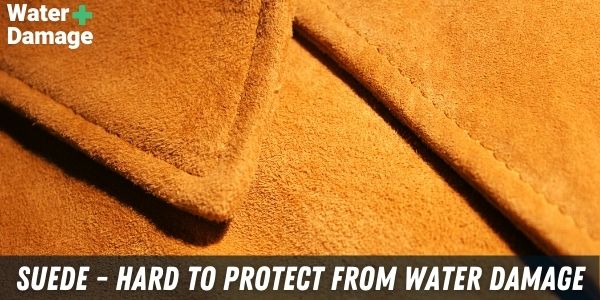
Suede looks great but it’s more susceptible to water damage and white unsightly streaks from becoming wet.
Suede leather is also trickier to protect from water damage.
It is best to spray suede rather than wax it.
If Still Wet
With suede items, take immediate action to minimise damage.
- Using a dry cloth or paper towel, carefully blot away excess liquid.
- Be sure not to rub the leather too hard.
- Then take a brush (or toothbrush) and gently brush over the pile of the suede.
- Take a hair dryer set to low heat and blow cool air over the surface, brushing while you do so.
- Keep moving the airflow, whilst also brushing, so the suede is able to fluff back up.
- Once the suede is dry, spray it with an appropriate water and stain repellent.
If Stains Are Dry:
If your wet suede item has already dried, returning it to its usual look is going to be much more difficult.
You can, however, improve the look of dried water stains on suede with these tips:
- First, remove as much dried dirt, stains or mud as you can with a dry brush.
- Next, dampen a soft cloth in one spot land use it over your index finger to lightly rub over the stained area.
- Start at the stain and work your way out to the edges.
- Repeat as necessary.
Finally, gently brush over the surface with a brush or toothbrush and then let the suede dry.
4. Nubuck leather
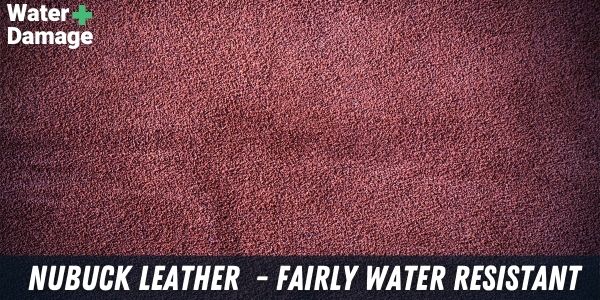
Nubuck leather is a buffed down version of leather which creates a durable texture that resembles suede.
This process makes the leather more water-resistant, but it is still advisable to use protector.
If Still Wet
- Gently blot away any surface liquid with a dry cloth or paper towels. Do not rub as you may damage the leather.
- Once the excess is removed, use a brush to brush over the leather, working from top to bottom and then repeating.
- Place the leather in a dry, ventilated area away from direct heat and leave to dry naturally.
- Once dry, apply leather conditioner.
If Stains Are Dry
If your nubuck leather item already has water stains in it, follow the steps above for suede and you will be able to minimize, and possibly remove the worst of the stains.
5. Faux Leather
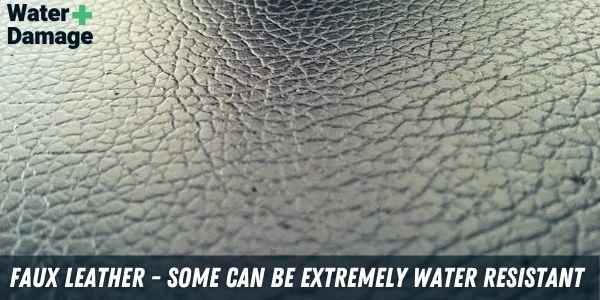
Faux leather is usually made from polyurethane plastic and is less likely to suffer water damage.
In most cases, water can be simply wiped away with a soft, dry cloth. It should be fairly robust and can even tolerate mild detergent for cleaning.
The only downside of this is that it also repels conditioning products, so it has less protection from drying, discolouration or cracking at it ages.
How to Treat Different Leather Items
Some of your leather goods will require special treatment whilst drying.
Wallets
Wallets are best left to dry in the closed position as it will be easier to open them than if they harden while open.
Handbags and Bags
Best to stuff with newspaper or another absorbent material until it is its usual shape, then let it dry lying flat.
Depending on the shape- Wider, chunkier or stiffer bags may dry better sitting up.
Briefcases
Lay it flat on a table or similar surface.
Fill the inside with newspaper to help keep the shape and absorb moisture.
Leave to dry fully by air, no heat.
Shoes and Boots
- Remove as much moisture, dirt and debris as possible.
- Remove any laces and the insoles if possible.
- Stuff with newspaper & Place the shoes somewhere to dry, on a shoe rack is ideal so air can circulate or elevated on their sides.
- Replace newspaper when wet and leave to dry fully.
- Do not use heat sources as the leather may warp.
- When dry use a mild white vinegar solution on any stains.
- Treat with conditioner to protect.
Water Damaged Leather Furniture
Leather furniture is a trendy, opulent style of decor for your home, but it also takes some time and care to keep it looking its best.
Water Damage To leather furniture can be catastrophic!
If a leather couch gets wet, it can cause stains, stiffness, discolouration.
It can also lose its natural shine, begin to crack, wrinkle or fade and even begin to look tired and shabby.
Properly cared for, however, it can last for many years.
Dealing with Water Spills on Leather Couch
It will happen eventually, whether it is red wine, cola or just plain water, it is going to end up all over your beautiful, expensive leather sofa.
It’s not just red wine that can leave a stain, even spilled water can leave its mark.
Moisture soaks into leather quickly and can affect its colour and texture if it’s not cleaned up quickly.
Act quickly and the damage can be minimised.
Stains don’t occur when moisture touches the sofa, only when left there to dry. The key to avoiding stains is cleaning up the liquid quickly.
- Use a damp cloth to wipe the moisture away.
- Blot first then wipe in circular motions away from the centre of the stain so that the edges of the stain can “blend” into the leather.
- Once damp, apply leather conditioner.
- Leave to dry for 8-10 hours.
- Afterwards, buff the surface of the item all over.
With some luck, the item should look as good new!
How to Fix Water Stains on Leather Couch
Vacuum or clean the sofa before attempting to remove any stains in order to remove any loose dust or dirt.
Use a vacuum cleaner with a brush attachment and be sure to get into the crevices to remove any crumbs.
If dusty, use a duster or dry cloth over the surface.
What Cleaning Solution to use
Opt for a cleaning solution made especially for leather or make your own by mixing water and white vinegar.
Avoid harsh chemicals and always spot test first.
Apply with a microfiber cleaning cloth. Rub lightly to avoid spreading the stain around.
Work from the centre of the stain outwards.
For Heavier Stains
For stubborn stains, you may need a stronger cleaning solution. Try saddle soap or natural beeswax products.
TIP; If you’re still unable to remove the stain, don’t continue to rub at the leather as this can cause more unsightly damage.
Hide the stain with cushions or covers or consult a professional cleaner for advice.
Dry the Sofa
After you have removed the stains the best you can, dry the sofa.
Use a cloth or towel to dry the surface.
Open the windows in your room and place the sofa in a well-ventilated area.
Condition the Leather
After your sofa is dry, treat it with a conditioner, rubbing into the leather with a clean, soft cloth.
Leave overnight. Use a dry cloth to buff the sofa the next day to bring back the shine.
TIP – If your leather sofa has any mold or mildew stains, simply fill a spray bottle with equal parts vinegar and water, spray onto the affected area and then quickly wipe away the stains.
Leave to dry fully.
Preventing Leather Water Damage
The best way to keep your leather items looking great is to protect them from damage before it even occurs.
Leather can never be totally waterproofed, but some treatments (sprays or creams) can certainly help it repel moisture more easily and buy you some time.
Beeswax cream also works well, but it doesn’t work as well with some leathers, so always test in an inconspicuous spot first.
Non-suede and non-nubuck items should be treated with a leather conditioner at least every six months.
Using a clean cloth, rub on with a circular motion, then wipe off any residue with a damp cloth and let it dry.
This will give good protection in future and keep your leather looking good.
When to Call a Professional
If you are unable to successfully treat your water damaged furniture and large leather household items such as bedframes, sofas or armchairs, get in touch with the team.
We have specialist equipment, cleaning products and leather restoration treatments that can help.
We have Water Damage Restoration Technicians that can help Deal with Water Damage on your leather furniture – as well as Repair any other Flood or Water Damage in your Home.
For Disasters of all Sizes,available in 95% of the USA
